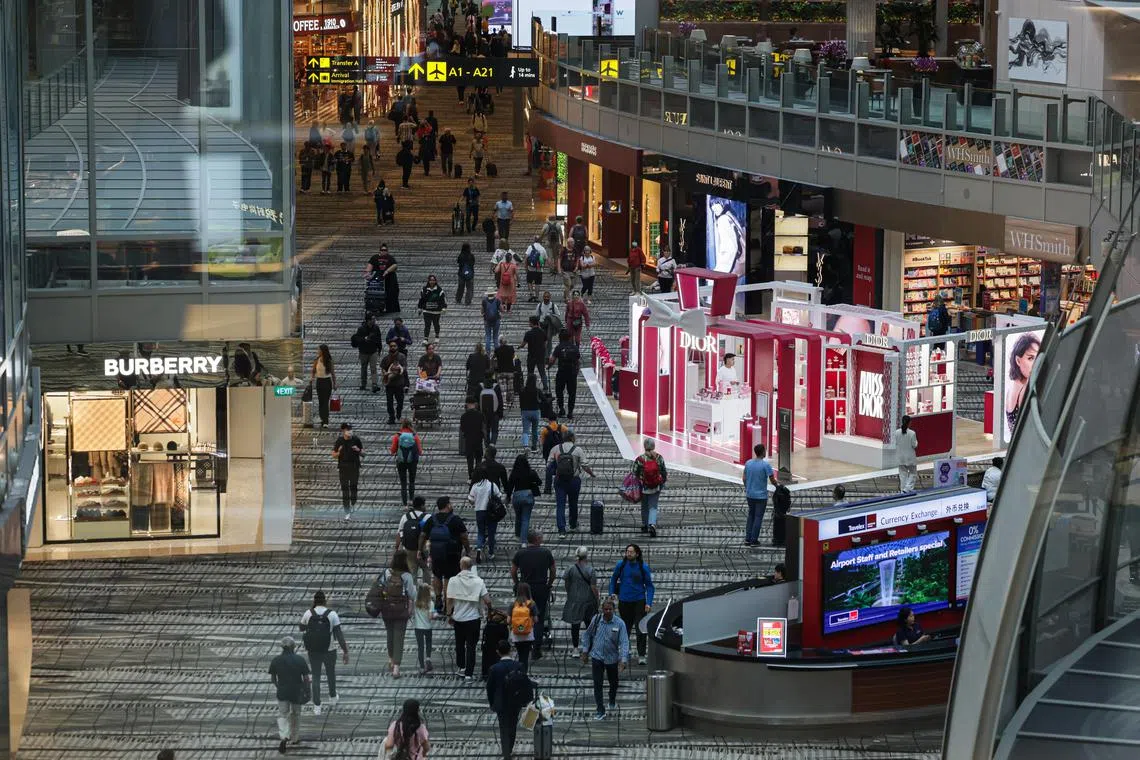Changi Airport’s passenger traffic hits 17.2 million in Q1 2025
Sign up now: Get ST's newsletters delivered to your inbox

Passenger traffic in the first quarter of 2025 was 4.8 per cent more than that in the first quarter of 2019, before the Covid-19 pandemic struck.
ST PHOTO: GIN TAY
Follow topic:
SINGAPORE – Changi Airport handled 17.2 million passenger movements from January to March 2025 – 4.3 per cent more than the figure recorded in the same period in 2024.
Also, passenger traffic in the first quarter of 2025 was 4.8 per cent more than that in the first quarter of 2019, before the Covid-19 pandemic struck.
These latest statistics were released by airport operator Changi Airport Group (CAG) at the annual Changi Airline Awards, held at The Ritz-Carlton, Millenia Singapore on April 24.
According to 2025 passenger traffic figures published on Changi Airport’s website, the airport handled 6.16 million passenger movements in January and 5.44 million in February.
This means that around 5.6 million passengers passed through Changi Airport in March.
China was Changi Airport’s biggest market in the first quarter of 2025 by passenger traffic, followed by Indonesia, Malaysia, Australia and Thailand, noted CAG.
Mr Lim Ching Kiat, CAG’s executive vice-president for air hub and cargo development, said the airport’s passenger traffic in the 12 months to March 2025 – totalling an all-time high of 68.4 million passenger movements – exceeded pre-pandemic levels for the first time.
He said this reflects positive trends in air travel, adding that CAG has been seeing “encouraging growth across all regions and key markets”.
In January, Transport Minister Chee Hong Tat said the authorities expect traffic volumes at Changi Airport to exceed pre-pandemic levels in 2025.
There were 94,000 aircraft movements – which include landings and take-offs – at Changi Airport in the first quarter of 2025, marking an increase of 5.2 per cent compared with the same period in 2024.
Traffic between Singapore and China registered a 10 per cent year-on-year increase, while traffic to and from Japan grew 16 per cent in the first quarter of 2025.
North America is the region that accounted for the highest growth at the airport in the first three months of 2025, with traffic increasing by 15.8 per cent compared with the first quarter of 2024.
Changi Airport handled 67.7 million passengers in 2024 – 99.1 per cent of the record 68.3 million handled in 2019.
In the first quarter of 2025, Changi Airport was linked to new cities, including Harbin in China and Labuan Bajo in Indonesia, as well as to Subang Airport in Malaysia.
As at April 1, some 100 airlines were operating more than 7,200 weekly scheduled flights at Changi Airport, linking Singapore to about 170 cities in 49 countries and territories around the world.
To improve passenger experience at Changi Airport, CAG chief executive Yam Kum Weng said the operator is planning to construct fully sheltered “satellite gates” where possible, so that passengers can board or disembark aircraft via gently sloped ramps that are connected to aerobridges.
These ramps will make it more convenient for the elderly, people with mobility issues and passengers with hand luggage, he added.
Mr Yam said each satellite gate is a fully sheltered building about the size of a tennis court. It will be connected to two aerobridges and can serve both narrow- and wide-body aircraft.
He added that CAG is planning for the first satellite gate to be ready before the end of 2025, and aims to build more of these gates around the airport.
CAG is also testing the use of mobile boarding ramps at places where it is not possible to build satellite gates, said Mr Yam.
“So with both the satellite gates and mobile boarding ramps, we will provide a seamless experience for passengers travelling between the terminals and remote aircraft stands, rain or shine,” he added.
These satellite gates are needed as more remote bussing during morning and evening peak periods is expected, since airlines prefer to operate more flights during these timings.
Remote bussing refers to transporting passengers between an arrival or a departure gate and the aircraft via an airside bus, instead of using a direct aerobridge.
Mr Yam also noted that CAG is working on improving the airport’s operational resilience through projects such as a management tool for aircraft turnarounds, Aircraft 360, which will improve the airport’s on-time performance.
An aircraft turnaround refers to the period between the arrival of an aircraft at its gate and when it departs for its next journey.
Mr Yam said that Aircraft 360 uses computer vision and artificial intelligence to monitor aircraft turnaround activities and predict potential delays in flight departures. Resources can hence be allocated quickly to minimise delays, and passengers can experience fewer travel disruptions, he added.
Once Aircraft 360 is rolled out fully at all terminals, Changi Airport will be able to accommodate 12 more flights each day using the gates with aerobridges during peak hours, Mr Yam said.
It is currently being used in Terminals 2 and 3 of Changi Airport.
At the awards ceremony, 25 awards were presented, including the Partner of the Year award, which was given to low-cost Indian carrier IndiGo.
This is because IndiGo, which now operates 75 weekly services between India and Singapore, has risen to become Changi’s fifth-largest foreign carrier by passenger traffic to date.
Awards were also given to the top five airlines based on the number of passengers on their flights. They are national carrier Singapore Airlines, low-cost airline Scoot, Malaysian low-cost carrier AirAsia, local budget airline Jetstar Asia Airways and Australian flag carrier Qantas Airways.


